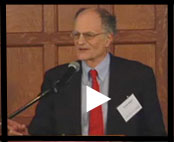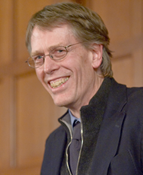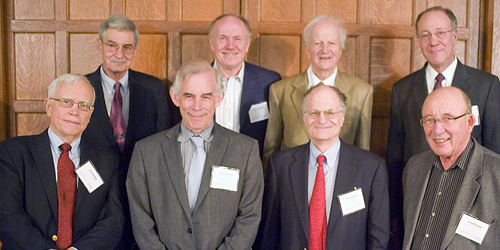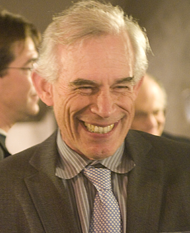A day of examining fiscal policy ended with celebration for two scholars who gave us the tools and insights to analyze such policy: the 2011 Nobel Laureates in economics, Thomas J. Sargent and Christopher Sims.
The pair was honored Nov. 18 at a dinner at the Becker Friedman Institute’s “Fiscal Policy Under Fiscal Imbalance” Conference. Sargent, a Distinguished Fellow at the Institute, co-organized the conference with Marco Basseto of the Federal Reserve Bank of Chicago. Sims, Harold H. Helm ’20 Professor of Economics and Banking at Princeton University, took part in the closing panel on the fiscal theory of the price level―a concept he played a key role in developing.
 Thomas J. SargentSix more Nobel laureates were among the friends, former students, and colleagues gathered for dinner at the Quadrangle Club to toast Sims, Sargent, and their seminal contributions to time-series econometrics and macroeconomics.
Thomas J. SargentSix more Nobel laureates were among the friends, former students, and colleagues gathered for dinner at the Quadrangle Club to toast Sims, Sargent, and their seminal contributions to time-series econometrics and macroeconomics.
View video »
Institute Research Director Lars Peter Hansen told the crowd that as a student and research assistant to both Sims and Sargent at the University of Minnesota in the 1970s, he had a front-row seat to the path-breaking work they produced.
“They were unique in the way that they used economic models along with time series data to analyze important policy questions,” Hansen said. Their insights “came only with rigorous economic modeling and careful empirical analysis.”
Work by Sims and others who used his methods challenged the standard monetarist view of macroeconomic policy and its impact on the economy, Hansen said. Sims’s empirical analyses produced economic models that showed how fiscal policy and its interaction with monetary policy―rather than monetary policy alone―determine price levels and inflation.
That is just one example of Sims’s impact, Hansen added. “His work is widely used in policy research from governmental agencies.”
“Sargent’s approach to research questions has been diverse and eclectic, continually searching and finding insight tools for interpreting economic time series,” Hansen said of his frequent collaborator. “Tom has complemented his empirical work with the willingness to explore an astonishing range of issues through historical analysis. He has examined European hyperinflations and strategies that nations have historically used to finance wars—questions with important implications for policy.
“I salute and offer a toast to Sargent and Chris, and encourage them to keep on inspiring us,” Hansen concluded. Lars Peter Hansen
Lars Peter Hansen
In an elaborate and entertaining analogy, 2004 Nobel Laureate Edward Prescott of Arizona State University compared the Minnesota team of Sims, Sargent, Neil Wallace, ECON PHD’64, and himself to the Four Horsemen of Notre Dame’s famed football backfield in the 1920s.
“We, the Four Horsemen, agree on the value of honesty, hard work, the strength of the language of economics and the need to make it more powerful,” Prescott said. “I offer a toast to Chris and Tom for this richly deserved award.”
Studying under Sims, Sargent, and others at Minnesota “was like being a kid in a candy store without budget constraints,” according to Martin Eichenbaum, the Ethel and John Lindgren Professor of Economics at Northwestern University.
“Do I really have to convince anyone in this crowd that they are extraordinary teachers, researchers and individuals?” Eichenbaum asked. “They are driven by the pure joy of intellectual discovery. When all is said and done, they just want to understand the chaos that we see when we stare out the window.
“They have something academics rarely speak of: courage―the courage to follow data wherever it leads. It is a privilege to be associated with this kind of people. I only hope all the young people in this audience have that kind of luck.”
Another former student, Tao Zha, now director of the Center for Quantitative Economic Research in the research department of the Federal Reserve Bank of Atlanta and professor of economics at Emory University, recalled the nerve-wracking experience of collaborating with Sargent on work exposed to relentless criticism from Sims.
“The rigor and high standards that Tom and Chris impose on the profession is nothing compared to what they impose upon themselves,” he said. “I was fortunate to work with both of them and am honored to call them friends. We are lucky to riding on the wave of modern econometrics pioneered by those two masters.”
Robert Lucas, whose Nobel prize-winning work on rational expectations motivated Sargent’s work in particular, recalled papers he wrote with Sargent and others critiquing inadequate views of how expectations were formed and worked.
“We knew what we were talking about, we created a stir, and people listened,” said Lucas, John Dewey Distinguished Service Professor in Economics. However, Lucas added, these critiques did not lead all the way to better models, and the work could have ended there. “I feel like Tom single-handedly stepped up. He saw the only way to move forward was to write down models of the same scope and ambition.
“Chris proposed the idea of time-series econometrics. This turned a corner,” Lucas continued. “There were plenty of critics of the model, but you could build on this stuff and move forward. A whole vigorous culture of macro model building has grown up since, with huge variety. What could have been an attack on use of high-tech econometrics turned out to be something much more interesting. When I look back, it’s a good thing Tom and Chris came along when they did.”
As the conference concluded the following day, Charles Evans, president of the Federal Reserve Bank of Chicago, offered a final toast to Sargent, Sims, and other scholars whose work shapes policy.
“Conferences like this are a fantastic collection of achievers coming together,” Evans said. He noted that the research innovations contributed by those in the room are important gifts, particularly important for the world of central banking.
“We at the Fed have a chair, Ben Bernanke, who listens to input, including input that is based primarily on the contribution of Sims, Sargent, Ed Prescott and others. There are not many more important words than this: ‘Ben, I have a model based on rational expectations that accords well with the observed data, and it says we should do X.’
“That’s powerful…and dangerous. We should all thank our lucky stars that with a room full of achievers like this, I can turn around and find someone who can say, ‘Yes, but I have a model that says, not X.’”
“Tom and Chris, thanks for your contributions in the name of better science and public policymaking.”
 Six Nobel Laureates in Economics turned out to toast the 2011 recipients (center front), Christopher Sims and Thomas Sargent. They are (clockwise from lower left) James J. Heckman, 2000; Robert Lucas, 1995; Edward Prescott, 2004; Gary Becker,1992; Roger Myerson, 2007; and Dale Mortensen, 2010.
Six Nobel Laureates in Economics turned out to toast the 2011 recipients (center front), Christopher Sims and Thomas Sargent. They are (clockwise from lower left) James J. Heckman, 2000; Robert Lucas, 1995; Edward Prescott, 2004; Gary Becker,1992; Roger Myerson, 2007; and Dale Mortensen, 2010.
